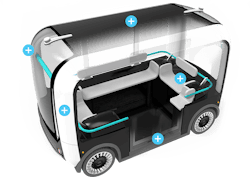Autonomous vehicles are in the news every day with more and more companies — and transit agencies — testing autonomous shuttles to determine their value in solving the first-last mile dilemma. Calstart recently hosted a webinar that provided insight on a future with autonomous mini-shuttles to give transportation professionals an overview of the technology and how some of the current autonomous shuttles operate.
And for transit agencies that aren’t looking at the autonomous arena, Calstart’s Michael Ippoliti, director Clean Transportation Solutions Group, pointed out that people are talking about a heaven and hell scenario that the industry needs to consider. The ideal scenario is that autonomous vehicles mean congestion is down, emissions are reduced and commuting is easier for people. The alternative is that there are more and more people with single-occupancy autonomous vehicles, or even cars out there with no one in them, congesting the streets.
“Transit folks will have to start thinking about this,” he stressed. “Sharing is transit. We will be facing competition from these new mobility providers. You have the opportunity to step up and leverage these technologies.”
Another reason for looking to autonomous is safety. While there’s no hard data yet, it is clear safety will improve. While initial systems will not be perfect, even in the current state it is better than human drivers that are sometimes distracted.
Autonomous 101
Calstart’s Michael Ippoliti, director Clean Transportation Solutions Group, provided background information on autonomous basics. One misconception he pointed out is that “connected” and “autonomous” are not the same thing, even though they are often inaccurately interchanged. “Autonomy doesn’t require connectivity,” he said. Though he pointed out that it is easier, more efficient if autonomous vehicles are connected.
When it comes to autonomous, he said, “To borrow from ZF, there are three elements involved of autonomous: See, Think, Act.”
- Sensors: Cameras, radar, lidar and sonar provides ultraprecise mapping.
- Sensor Fusion: Powerful processors come in to play, which were specifically built for this purpose.
- Control Decisions: The software that makes decisions will become a source of brand differentiation.
- Actuation: The vehicle acts on the control decisions, manipulating the vehicles. This is one of the areas electric vehicles (EVs) have a benefit because everything is already controlled electrically and by a computer.
There are six levels of automation for on-road vehicles, as defined by SAE J3016.
- No Automation - The full-time performance by the human driver of all aspects of driving
- Driver Assistance - The driving mode-specific execution by a driver assistance system of either steering or acceleration/deceleration using information about the driving environment with the expectation that the driver performs all remaining aspects of driving.
- Partial Automation - The driving mode-specific execution by one or more driver assistance systems of both steering and acceleration/deceleration using information about the driving environment and the expectation that the driver performs all remaining aspects of driving.
- Conditional Automation - The driving mode-specific performance by an automated driving system of all aspects of the dynamic driving task with the expectation that the driver will respond appropriately to a request to intervene.
- High Automation - The driving mode-specific performance by an automated driving system of all aspects of the dynamic driving task, even if a driver does not respond appropriately to a request to intervene.
- Full Automation - Full-time performance by an automated driving system of all aspects of dynamic driving.
The autonomous shuttles talked about during the webinar are at levels 4 and 5.
Tomorrow's Vehicles Today
Lauren Isaac, director of business initiatives at Easymile, and Hugh Palmer, VP of product manager at Local Motors, provided information about the vehicles those companies manufacture and Matthew Lesh, chief commercial officer at Coast Autonomous, discussed software.
These driverless shuttles currently operate short distances in a confined space, including train stations, amusement parks, academic campuses, retirement homes, airports, city centers, hospitals and industrial sites.
Easymile’s EZ10 is a driverless, electric shuttle that can carry up to 12 people (6 seated, 6 standing). There’s a built-in access ramp for passengers with reduced mobility. The shuttle can accommodate one person in a mobility device with 6 seated.
The vehicle operates on a fixed schedule or on demand. They can operate up to 10 hours and the average speed is about 10 mph, though can go faster depending on the risk assessment of the service area.
Palmer provided information on Olli, a shuttle that uses IBM Watson as a human interface to give personality to the vehicle.
Olli is an open platform and is mostly 3-D printed so the vehicle can be upgraded easily for new technology, sensor sets, new sensor locations, other hardware accommodations or to change the interior configuration. The open platform allows it to keep pace with the quickly evolving autonomous innovation.
“The focus for us is not just transportation solutions, but to create an experience,” said Palmer. They do that through human machine interfacing (HMI) and IBM is a key partner. With no driver, who becomes the host, Palmer asked.
“The HMI enables us to pull up to a passenger in a ride-hail-type of environment … talk to the rider by name … have a relationship with that person,” Palmer explained. “It can anticipate where they might want to go. The user can ask questions: ‘Where’s the best place to get pizza?’”
As with Easymile, Local Motors is focused on accessibility. Palmer said they focus on four areas of accessibility: physical, vision, hearing and cognitive impairment. Some of the things he mentioned included software that would ask a passenger if it forgot something if it senses anything left behind, leading someone with a visual impairment to an available seat and automatically deploying a ramp based on a profile setting within the app.
As an autonomous vehicle company, not a vehicle manufacturer, Lesh said Coast Autonomous is focused on the vehicle and the software in the vehicles. They are looking at autonomous technology improving efficiency, decreasing congestion, providing access to mobility that can’t drive or choose not to drive.
A connected environment, he said, can offer a personalized way for people to move about our cities, can help transportation managers efficiently manage their systems and can provide the opportunity to reclaim green space from infrastructure.




